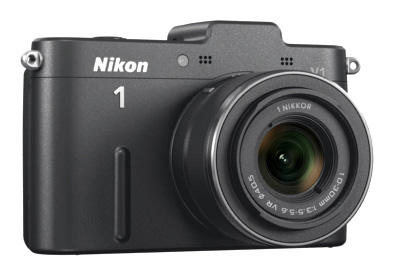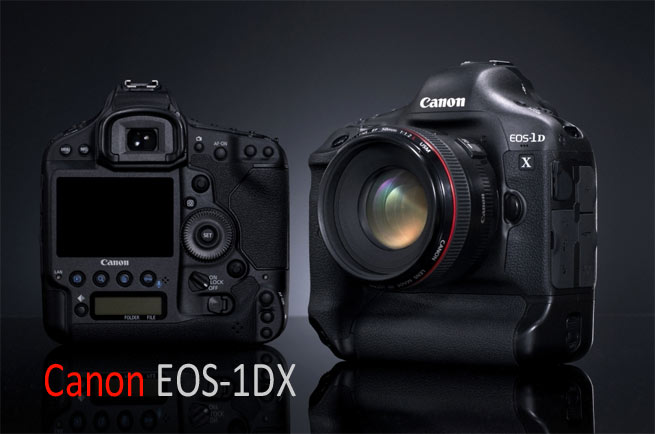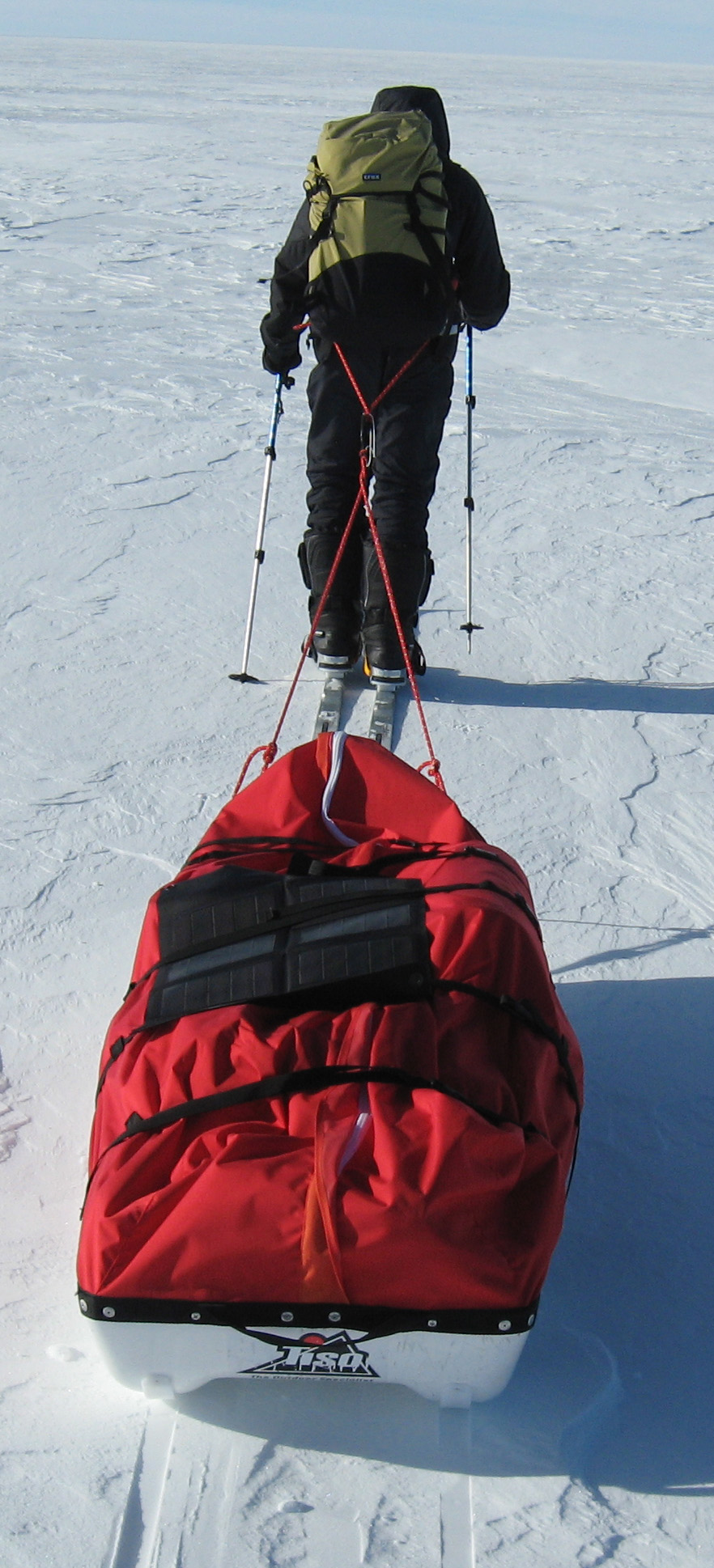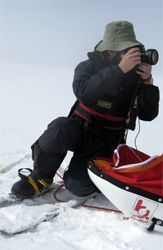Photography in the freezer.....
I'm often asked about the practicalities and realities of taking photographs in the cold regions of the world, especially what equipment to use. Photography is a significant part of my livelihood and so often my planning for photographing a destination is as critical as for the journey itself. I think I'll split the answer into a few different chunks:
What are the photos you want to take for:
I'm thoroughly against the modern trend of everyone getting a digital SLR camera (DSLR) - there you have it. It think it's a waste of money and effort in a vast majority of cases and actually leads to the worst possible thing - people not taking photos when they perhaps could be. This purchasing faux pas is largely due to people not thinking fully about the end product they want from their photographs. There's also the fact that the cameras are vastly more affordable than even when I began agency photography in 2002. My first DSLR was 6 megapixels, had borderline unusable autofocus and was useless above ISO 400, yet cost £1900. Now you can get a body for £400 which destroys my old Canon D60 in every department. There's also a certain degree of envy - people want to be seen to have the best, 'professional' looking gear, even if they have no intention of using 5% of its capability.
 Nikon J1 compactIf your output is for web, slideshows and printing up to A4 size in the years to come, do yourself a favour and get a well made and capable compact camera or 'cut-size' pseudo-DSLR. They can cost well under £400 even with quality lenses, capability for external flash and critically, can be pocketable. Great for expeditions, polar ones especially. Drawbacks can be poor low-light performance, slower autofocus when shooting action and no live optical viewfinder. Yes, a £6000 Canon 1DX is better, but for the output I describe, is massive overkill. Good examples include the Canon G12 or S100 and Nikon V1 and J1. Even smartphones (touch screens can be dodgy in low temps) can now produce exactly what you want for this need, which covers almost every expeditioner I've ever met. Don't get sucked in by gear-envy and end up overbuying.
Nikon J1 compactIf your output is for web, slideshows and printing up to A4 size in the years to come, do yourself a favour and get a well made and capable compact camera or 'cut-size' pseudo-DSLR. They can cost well under £400 even with quality lenses, capability for external flash and critically, can be pocketable. Great for expeditions, polar ones especially. Drawbacks can be poor low-light performance, slower autofocus when shooting action and no live optical viewfinder. Yes, a £6000 Canon 1DX is better, but for the output I describe, is massive overkill. Good examples include the Canon G12 or S100 and Nikon V1 and J1. Even smartphones (touch screens can be dodgy in low temps) can now produce exactly what you want for this need, which covers almost every expeditioner I've ever met. Don't get sucked in by gear-envy and end up overbuying.
If your output is for commercial, editorial or large reproduction size, or involves fast moving and tricky subjects (not polar skiers!), then yes a DSLR is vital. Put simply, if you need a large DSLR with top quality interchangeable lenses, you'll already know you do. If you don't, you probably don't need more than a quality compact. Modern DSLRs provide staggering resolution when viewed at 100% magnification, 100% coverage optical viewfinders, accurate and fast autofocus and good low light performance. Canon 1DX You can also control complex off-camera wireless flash arrays. My photographic agency, Getty Images, has brutally strict technical requirements and I so take the weight penalty of a large DSLR in return for profitable, commercial images down the road. Equipment ranges from £500 for low-end consumer bodies to £6000 for the most able cameras and then most quality lenses are between £500 and £5000. Examples include the Canon 5D Mark II, 1D Mark IV and 1Ds Mark III and the Nikon D300, D700 and D3 series.
Canon 1DX You can also control complex off-camera wireless flash arrays. My photographic agency, Getty Images, has brutally strict technical requirements and I so take the weight penalty of a large DSLR in return for profitable, commercial images down the road. Equipment ranges from £500 for low-end consumer bodies to £6000 for the most able cameras and then most quality lenses are between £500 and £5000. Examples include the Canon 5D Mark II, 1D Mark IV and 1Ds Mark III and the Nikon D300, D700 and D3 series.
So, once the type of camera you're after is decided, most of the subsequent cold-weather and expedition considerations are relevant to both a £100 snapomatic and a £6000 monster:
Battery-life
Most modern cameras use Lithium-Ion or Lithium-Polymer batteries, which are a vast improvement over those available five years ago. They don't suffer from memory effect and don't self-discharge fast. Yes, they run down fast when cold, but their initial capacity is generally so high for a given size that it's not an issue. As a comparison, the 12V NiMH battery I used in my Canon 1D Mark IIN in 2008 needed a charge every few days after moderate use and weighed a ton. In 2010/11 my 7.2V Li-Ion battery in my 5D Mark II was charged once in a fortnight and even fed back information about its exact charge level and how well it's charging. Batteries are no longer a major issue.
Cards
CompactFlash, xD, SD, whatever. Get a big one, but not too big. If one fails (which they rarely do), you don't want to lose everything. I use lots of 8Gb cards for my 21MP RAW files. They hold around 250 images each. Don't worry about 500x or 1000x speed cards unless you're shooting at 10 frames per second. Good brands are Integral, SanDisk and Kingston.
Viewfinders
DSLRs tend to have nice big viewfinders, especially full frame ones like Canon 5D and 1Ds series bodies, but they can be a hassle to use with large goggles on. Compacts have useless optical viewfinders or none at all, so you use the LCD screen on the back, which can yomp through batteries. Be discerning about how long you use this feature or have an effective battery charging system.
 Charging
Charging
This is difficult. Your options are charging the proprietary batteries from custom-12V AA powerpacks and DC car chargers or using the same charger with a solar panel and a reservoir intermediate battery. Which of these you use depends largely on the terrain you're travelling over and the relability of light-levels. Early-season North Pole expeditions will favour AAs and mid-summer icecap expeditions will favour solar.
Formats
Storage is cheap and so if you want plenty of opportunity to edit, shoot RAW, not jpeg. In the unreliable and pressured shooting conditions of an icecap, you often won't get the exposure perfect in camera and so flexibility of RAW after the fact is very welcome. Even cheaper compacts have RAW now, but expect to spend time in the edit suite once home. If this is too much hassle and you just want snaps for sponsors or blogs, stick with the smaller and better 'out of the box' results of the jpeg format.
Weather-sealing
In conditions where humidity changes a lot from a steamy tent to a dry icecap, a camera with weather-sealing is very useful. Canon 1D, 5D, 7D and pro-compacts are sealed with O-rings to various extents and other competitors have their equivalents.
Video
A few years ago if you wanted to shoot stills and video, you needed a stills camera and a video camera. Then, compact cameras developed basic filming ability. Now, both compacts and SLRs have video capability, often up to 720p or 1080p High Definition. Excellent news for weight conscious expeditions. Remember though, don't just go for the biggest and the shiniest. Think about the end use of the video and buy accordingly.
Exposure and Autofocus
 These concepts, which are the true photographer's bread and butter in the warmth of home or a studio, take on a lesser role at the Poles. With the flexibility of RAW formats, slow-moving simple subjects, excellent modern autofocus systems and difficult shooting conditions, I tend to use one-shot centre point autofocus and evaluative metering for the vast majority of situations.
These concepts, which are the true photographer's bread and butter in the warmth of home or a studio, take on a lesser role at the Poles. With the flexibility of RAW formats, slow-moving simple subjects, excellent modern autofocus systems and difficult shooting conditions, I tend to use one-shot centre point autofocus and evaluative metering for the vast majority of situations.
I hope these tips help those who wish to photograph their cold-weather expeditions, whether for 1 inch wide blog photos or boutique agency promotion globally. It's an endless subject and so please do ask other questions in the comments section!